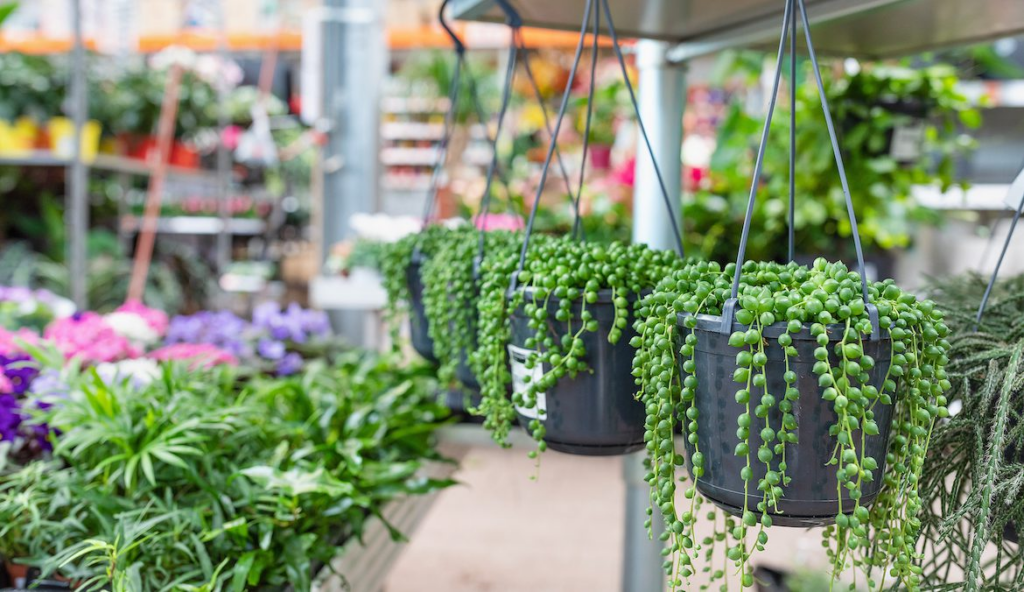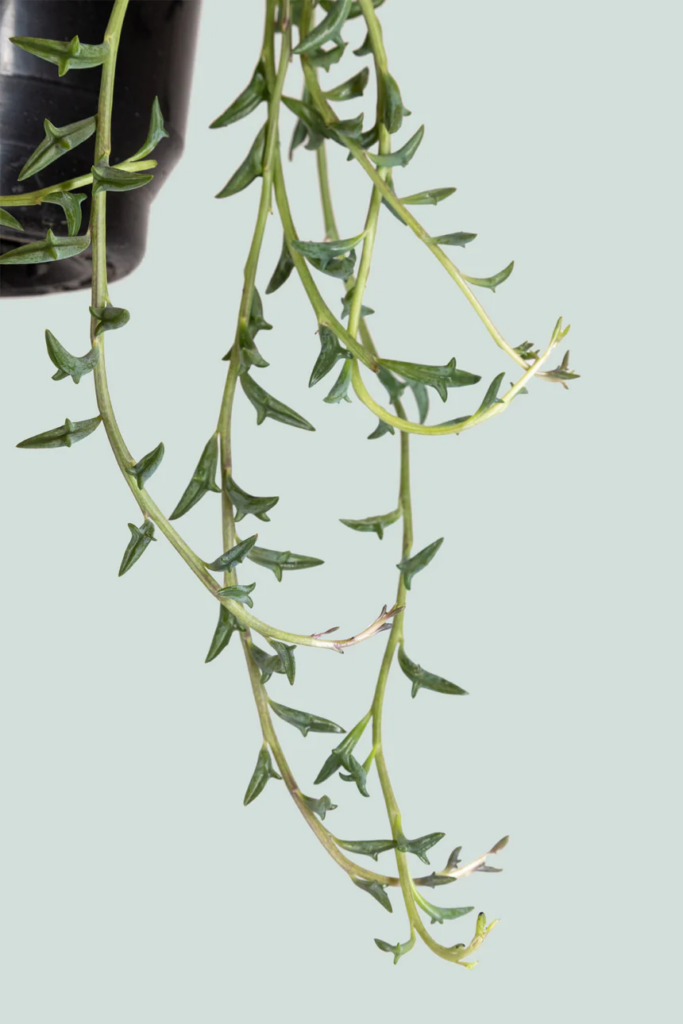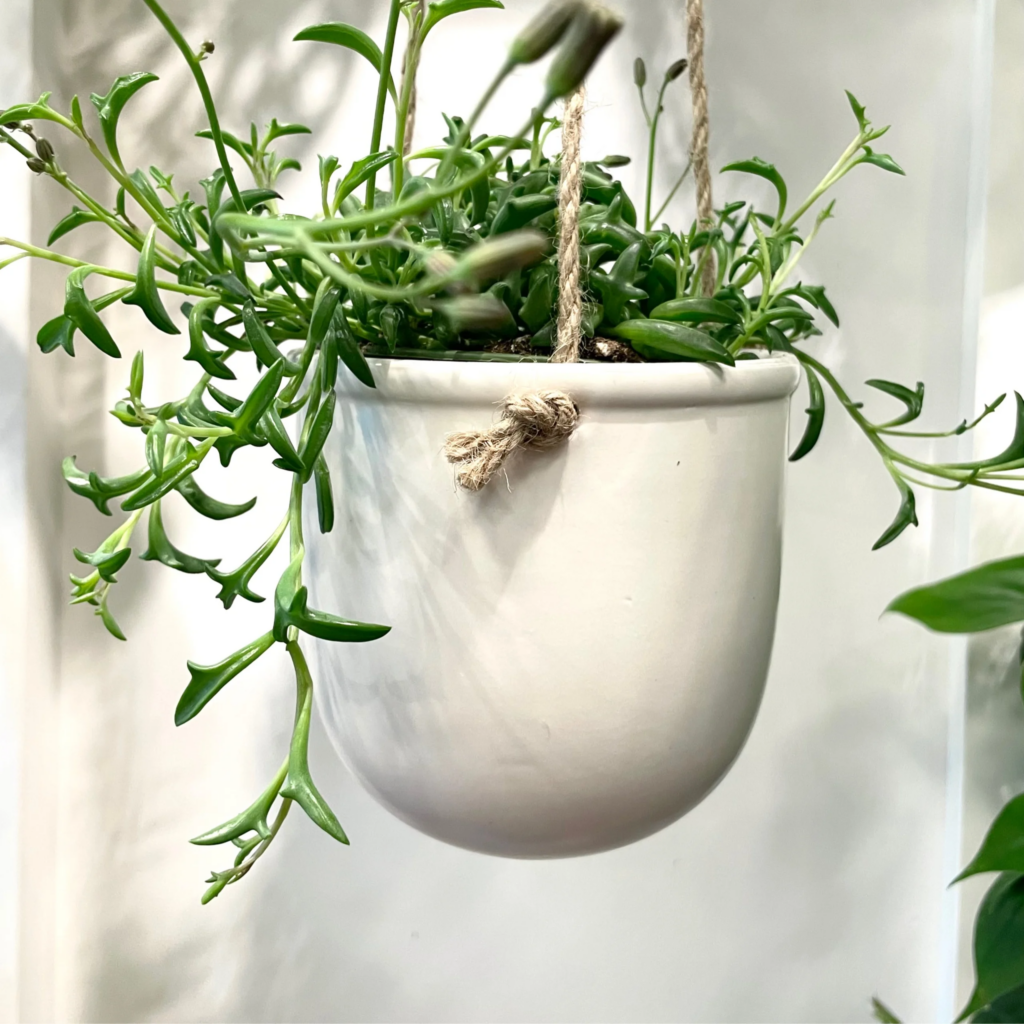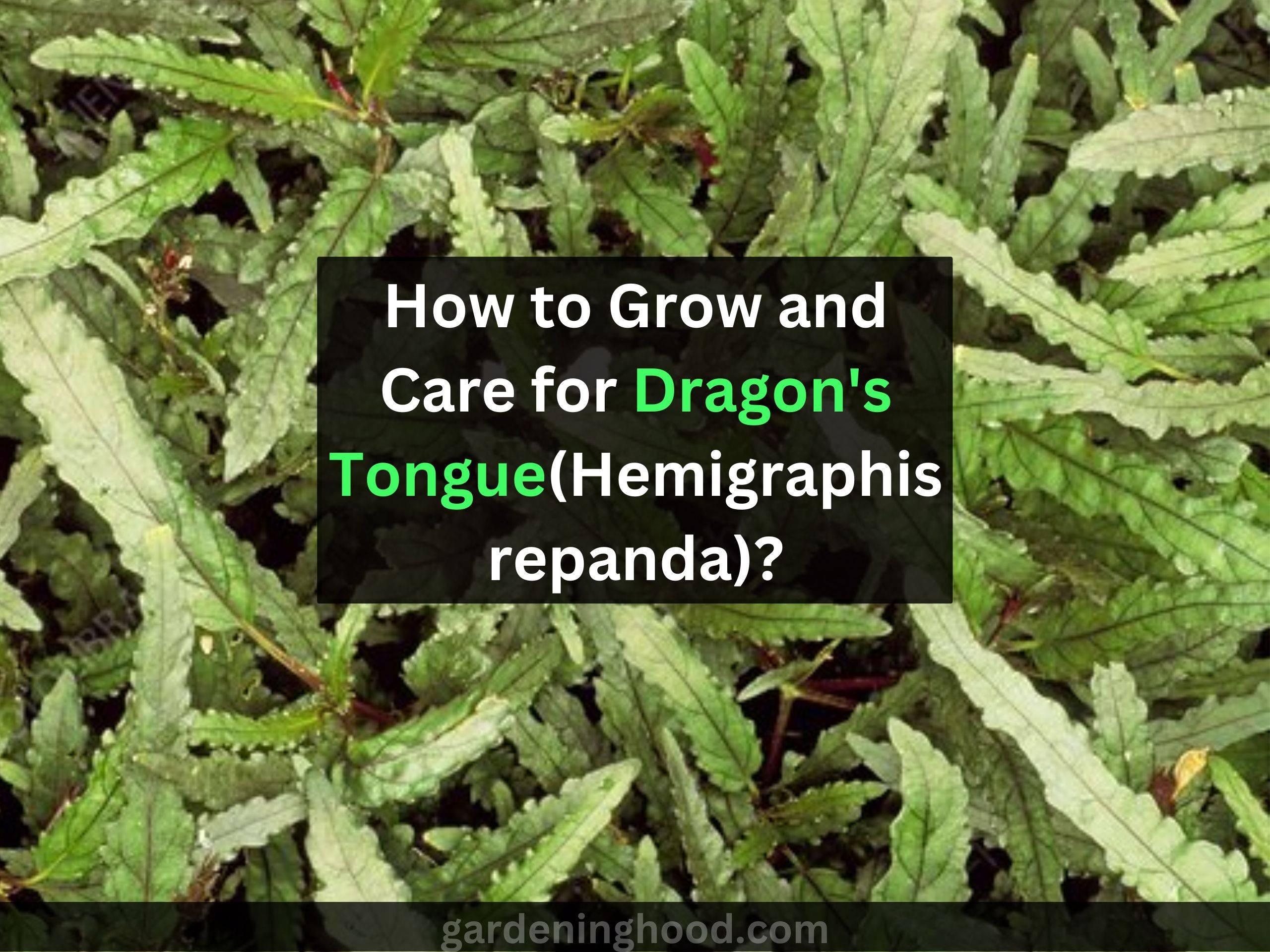How to Propagate the String of Dolphins- Full Guide
I love to decorate my house with indoor plants, and while planting, I came across the string of dolphins, which I like so much that I wanted to buy more but didn’t have the money. So, I decided to propagate the plant. Yes, you heard it right! I know many of you face this problem, so after practice and hard work, I succeeded in propagating the string of dolphins.
Here, I have shared all my experiences and strategies that I practiced while propagating them. Further, if you have any doubts, please mention them in the comments below.
String of Dolphins:
Talking about them, you can characterize the string of dolphins with their iconic dolphin-shaped leaves and hanging tendrils. The plant is used to grow interesting foliage rather than flowers. If you grow them in hanging baskets, the string of dolphins adds more beauty to the space, and in a vertical garden, growing them upwards on a trellis or moss pole is a great option. They are not considered frost-tolerant succulents and need warm weather year-round to survive outdoors.
| Botanical Name | String of dolphins, dolphin plants, flying dolphins, the dolphin necklace |
| Common Name | String of dolphins, dolphin plants, flying dolphins, the dolphin necklace |
| Plant Type | Succulent |
| Mature Size | 6 inches tall |
| Sun Exposure | String of dolphins, dolphin plants, flying dolphins, the dolphin necklace |
| Soil Type | Well-draining, cactus/succulent soil |
| Soil pH | 6.6-7.5 |
| USDA hardiness zone | 9b to 11b |
| Bloom Time | Spring |
| Flower Color | White |
| Native Area | Southwest Africa |
| Toxicity | Toxic to dogs and cats |

Propagating the string of dolphins:
The following are some different methods for propagating the string of dolphins:
Propagation from Stem Cuttings:
- Using stem cutting is a common method for planting new plants by using parent plants.
- Propagating the plant does feel like giving the plant a haircut and watching it grow into a new look.
- To start propagating you need to first sterilize the non-negotiable cutting tool.
- Using dirty tools will cause the plant to get infected.
- Now cut a healthy stem from the mother plant which is a piece a few inches long and contains few nodes.
- Propagating the cutting is like giving them new life which you can grow either by placing them in water or directly in soil.
- Patience is the key if you are choosing to grow a string of dolphins in water where the roots take more time to grow.

Propagation from Offsets:
- Offsets are the little pups that are produced by the string of dolphins naturally.
- Make sure to find a healthy offset that needs to be in a good size and own roots.
- Be careful while separating the offset from the parent plant for which always use a sterilized tool that will avoid damaging the parent plant.
- Make sure to plant the offsets in suitable pots using well-draining soil.

Propagation from Leaf Cuttings:
- Using leaf cutting to propagate is similar to using stem cutting.
- To propagate using leaf cutting you need to select a healthy lead node.
- Now you need to prepare the leaf by letting the cutting dry out for a day or two all of this will prevent the condition of the root root.
- Now place the leaf-cutting in a medium such as soil or water.

Propagation Care and Maintenance:
The following are some ways to take care and maintain the string of dolphins:
Environmental Conditions:
- The light, temperature, and humidity do play a vital role in growing string of dolphins.
- Providing the plant with bright indirect light will be the best place to keep the plant.
- If the plant is getting too much direct sunlight will scorch the baby dolphins and getting too little light will stunt the growth of the plant.
- You need to maintain a temperature that is not too hot, not too cold just aim to get 73-77º F.
- In case of using bottom heat, there you need to keep the air temperature between 68 and 73º F and if you are not using bottom heat maintain the air temperature upto 77-80º F.
- You need to maintain the humidity above 85% which you can get by misting or a humidifier.
Watering and Fertilizing:
- Watering the string of dolphins is important to growing them as overwatering the plant will lead to root rot and underwatering will lead to wilting.
- In the case of soil propagation, you need to light mist the soil when the roots grow.
- If you are doing water propagation you need to change the water for about 1-2 times a week.
- The fertilizing plant is a way to provide multivitamin for the plant.
- Now wait for a few weeks after you propagate then only start fertilizing.
- There are most of the potting soils that come with a little fertilizer.

Post-Propagation Care:
The following are post-propagation care required by String of Dolphins which you need to follow for growing the string of dolphins:
Acclimatization and Care Routines:
- It is really possible to get a baby string of dolphins if you provide them with TLC. Acclimatization.
- The new plantlets you find on cutting are like toddlers getting to the new playground.
- The plants are getting used to their new environment.

Watering and Light Requirements:
- Make the soil dry out slightly between watering the plant because watering too much or not too little will harm the plant.
- Providing the plant with bright indirect sunlight will be perfect for them but direct sunlight will cause sunburn and nobody likes crispy dolphins.
Humidity and Temperature:
- The string of dolphins prefer to grow slightly in humid environments.
- To maintain the humidity use a plastic bag or a humidity dome will help the plant retain moisture.
- You need to maintain the room temperature between 15°C (59°F) – 25°C (77°F) which will be perfect for growing the string of dolphins.
Monitoring Root Growth:
- The root growth will take serval weeks to months to grow so, you need to have patience.
- Make sure to check the signs of growth and remember patience is the key to success.
Promoting Healthy Growth:
- To ensure the growth of the newly propagated string of dolphins.
- You need to provide the plant with the right condition and care to promote healthy growth.
- You need to remember the dolphins are not surviving they are thriving.
Monitoring and Troubleshooting:
Here are some ways to monitor the string of dolphins:
Keeping an Eye on Progress:
- You need to monitor the dolphins to be successful in growing the plant.
- The growth of the root will get started within a couple of weeks.
- In case you are propagating the plant using soil then keep it moist until the root grows and if you are using water make sure the bottom leaves don’t rot.

Troubles in Paradise:
- The common issue that you can find in a string of dolphins can be overwatering the plant which will lead to root rot.
- If you find the plant more looking like a String of Raisins than Dolphin it means the plant is dealing with the problem. To recover them cut watering the plant frequently.
The Pests:
- Mealybugs are common pests that can be seen in the string of dolphins which are tiny, cottony white pests that feed on plant sap which leads to sooty mold and yellowing of leaves.
- You need to inspect the plant regularly which is an important step.
- To get rid of mealybugs you can use rubbing alcohol-soaked cotton swabs that will help to manually remove the pests.
- You can also use natural insecticides like insecticidal soaps or horticultural oils to get rid of them.

Leggy Growth:
- In case the plant is looking leggy it means the plant is not getting enough light.
- You need to move the plant to a well location or you can provide the plant with artificial growing lights.
- The pruning of the plant does promote the plant growth compact and bushy.
Leaf Loss:
- The plant can suffer from leaf loss because of overwatering, insufficient light, or physical damage.
- To encourage stronger leaves maintain proper watering, and light exposure, and make sure to handle the plant carefully.
The Rot:
- In case you find rot developing on the cutting of the stem or node it’s normal to find that.
- If the roots get themselves rotting that is not normal and will result in problems.
Common Mistakes to Avoid:
Here are some common mistakes that you need to avoid for growing the string of dolphins:
Cutting in the Wrong Place:
- It’s not just taking old snip-cutting to propagate the plant.
- You need to follow the proper steps to propagate the plant starting from choosing a stem to plant them in soil or water.
- Always cut below the leaf node.
- You find magic where you can differentiate tissue and create a callus that will result in successful rooting.

Blunt Tools:
- If you are using a dull pair of scissors it will be messy and will not end well.
- Always use sharp, clean tools for propagating the plant which will prevent damage and growing of bacteria.
Skipping the Callus Stage:
- There may be a possibility to may get tempted to skip the callus stage but for success in propagating don’t skip.
- Allow the cutting to callus which will prevent rot and will be helpful in successful rooting.
Wrong Soil Mix:
- If the making of soil is not created equally then the result will not end well.
- If you plant them in the wrong soil mix will be like trying to grow a cactus in a swamp.
Rooting Everything in Water:
- It is not to be always right while rooting in water.
- To root the plant in water is like to make every recipe in a cookbook using a microwave.
- Some plants prefer soil, I mostly prefer the string of dolphins to grow in soil.
Forgetting to Change the Water:
- In case you are choosing water propagation need to remember to change the water regularly.
- If you leave the cutting in stagnant water it will feel like taking a bath and never going to drain the tub which is not good.
Waiting Too Long to Transplant:
- You don’t need to wait for longtime which will lead them to overgrow roots and a tricky transplant.
In the end, I suggest you to all the common mistakes then there is a chance of success in propagating the string of dolphins.
Benefits of Propagating String of Dolphins:
Here are some benefits of propagating the string of dolphins:
Spread the Love:
- You can give the plant to your friend who loves plants because they do have a unique appearance.
Expand Indoor Jungle:
- Propagating the string of dolphins helps to multiply the plant collection.
- I will say it’s like the buy-one-get-many-free deal in which you are not buying you are snipping.
Witness the Magic:
- Nothing can be more satisfying than watching a tiny cutting sprout roots and grow into a fledged plant.
- It is like a miracle to watch the plant growth closely.
- Propagating the plant does provide them with wondering shapes and you will get to feel proud plant parent when you see the cutting to thrive.
Timeline for Propagation:
To propagate the string of dolphins you need to have patience which is the key to success. The timeline for propagation can vary according to the condition but here I have explained the general idea that you will see.
Root Development:
- The first step is growing the roots which is a sign of success either you propagate in water or soil the tiny roots sprout from the nodes.
- The root will develop within a couple of weeks but also can take longer time depending on the conditions that is provided to the plant.

New Growth:
- After developing roots, the next you will see the growth of new leaves.
- You will find new leaves to sprout within a month of rooting them but also remember each plant is different and does take its time to grow.
Maturing the Plant:
- When you propagate the plant it will continue to get mature in a healthy way.
- They will reach full maturity in up to 2 years.
Seasonal Considerations:
- The growth rate of the plant fluctuates with the season.
- The string of dolphins is used to grow more rapidly during the warmer months and slow its process during the cooler months.
- You need to wait to get the joyful watching of plant babies growing.
Potting and Repotting Propagated Plants
Potting Rooted Cuttings and Offsets:
- After finding the string of Dolphin cutting or offset has developed enough root then, it’s time to move the plant.
- To move the plant select a small pot that will provide stability to the plant without drowning the root in excess soil.
- Don’t use over large pot which will lead to the problem of overwatering and root rot.
- After finding the suitable pot fill the pot with a well-trained potting mix and make sure the root gets stuck into it comfortably.
- Make sure to place the pot in a place where it gets bright indirect light because direct sunlight is harmful to the tender roots to handle initially.

Repotting Established Plants:
- After propagating the string of dolphins you will find out the growth of the plant out from its container which is a good problem but you need to take action quickly.
- To repot the plant always choose a pot that is 2 inches wider than the previous one.
- Using too large pot will slow the process of drying of soil.
- You need to gently lift the plant and let the roots get free from the planter.
- Need to inspect the route ball and remove any dead or rotting roots present on the plant.
- In the case of root-bound conditions, you need to cut through the roots to prevent them from encircling.
- You need to fill the new pot using soil and tempting it down gently so that you can use water to settle the soil but avoid the condition of overfilling.
- Repotting the plant is a shock for the plant so it is normal for the plant to show some changes in leaf as they are adapting to the new environment.
- You need to trim the declining leaves so that the plant regains energy and gets properly rooted in the soil.
- You need to have patience because the plant will not grow overnight and not be able to adjust to the new pot overnight but by providing the plant with the right care it will come back within no time.
General care:
In order to grow a string of dolphins Successfully you need to fulfill all their basic requirement that I have mentioned below:
1. Light requirements:
- The string of dolphins are used to get sunburn if they get exposed to too much of the Sunlight.
- They don’t come under heat-loving succulents so make sure not to give them direct sunlight.
- In case wanting to place them with other plant collections outside always place them in a shaded spot where they get only indirect or filtered sunlight throughout the day.
- They used to thrive best in zone 10.
- In case you are keeping the plant in the south-facing window provide them at least 6 hours of morning sunlight per day.
- Not getting the light requirement you can place the plant under a T-5 fluorescent or LED Grow Light if needed during winter.
2. Ideal temperature:
- The perfect temperature for a growing string of dolphins is around 72 degrees Fahrenheit.
- They do love cool air and are able to grow in temperatures as low as 40 degrees Fahrenheit during winter.
- During the summer season or the growing seasons need to maintain the temperature around 72 degrees Fahrenheit.
- The string of dolphins are soft succulent which means they are not able to survive in hard frost so, move the plant inside when the temperature gets colder than 30 degrees Fahrenheit.
3. Soil & fertilizer:
- Avoid the condition of over-watering the String of Dolphins which will make root rot.
- Always choose a well-draining soil such as cactus/succulent mix to fill it in a container having enough drainage holes in the bottom.
- The plant does not require much fertilizer and providing the plant over fertilizer will lose their natural look.
- The best way to fertilize them is to use them only once or twice a year at the beginning of spring because here the plant begins to bloom
4. Watering needs:
- The string of dolphins is easy to water not unlike other rare succulent which gets super tricky to water.
- To water the plant first, soak the water until the water runs out of the drainage hole and make sure the soil dries completely between the watering schedule.
- You need to water the plant once per week during the growing season and once per month during the winter dormant period.
- The adjustment of watering schedules can be done according to the plant’s need which depends upon the location you are living.
Ways to make a string of dolphin bloom:
During the spring to early summer months when the string of dolphins gets mature start to form small clusters of dainty and white flowers with cinnamon-like fragrances. The quality of the flower does depend upon how you have cured the plant during winter dormancy. The following are some ways to make a string of Dolphin bloom:
- During the late autumn to Early Spring season, you need to reduce the temperature to around 59 degrees Fahrenheit.
- Make sure the soil gets dry out between the irrigation.
- You need to provide the plant with 2 to 3 hours of peak direct sunlight and fertilize the plant from late autumn to early Spring so that the plant goes well in dormancy.
- You need to keep the succulent little root bound.
Meaning of DORMANCY:
The plant is used to go dormant during the winter season in which they deal with temperatures 50 to 55 degrees Fahrenheit. Here you need to water the plants less such as watering them once a month to keep the plant growing happy and healthy.
Final Word:
Propagating the plant doesn’t always give success but if have read the article carefully and followed all the steps to propagate a string of dolphins then there will be a high success rate.
Just remember to keep trying, learning, and enjoying the process. Never get depressed by failures


